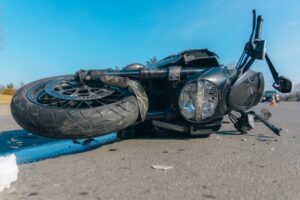
The most common causes of death in motorcycle accidents include head trauma, chest and spinal injuries, and collisions involving impaired drivers or hazardous road conditions. These fatal outcomes are often tied to the rider’s lack of physical protection and the intensity of impact during a crash.
Motorcycles offer freedom and agility, but without seatbelts, airbags, or protective frames, riders face a much higher risk of fatal injury. In many cases, a Davie motorcycle accident lawyer can help determine whether negligence—such as poor road maintenance or another driver’s actions—contributed to the loss of life.
1. Head Trauma
Traumatic brain injuries are the leading cause of death for motorcyclists. Florida riders over 21 aren’t required to wear a helmet if they carry specific insurance coverage, but the absence of a helmet in a crash often leads to fatal outcomes.
Even with a helmet, high-speed or high-angle impacts can result in:
- Skull fractures
- Internal brain bleeding
- Brain swelling (edema)
- Loss of consciousness or brain death
Many of these injuries prove fatal before emergency responders arrive, especially if the crash involves high speed or multiple vehicles. If you have lost a loved one, a Davie personal injury lawyer can help you seek compensation.
2. Thoracic Injuries
Injuries to the chest—often referred to as thoracic injuries—are a major contributor to fatal outcomes in motorcycle crashes. The chest houses vital organs, including the lungs and heart, which are highly susceptible to blunt-force trauma during a collision.
We’ve seen fatal thoracic injuries caused by:
- Rib fractures puncturing the lungs
- Cardiac contusions (bruising of the heart)
- Tears in the aorta or other major blood vessels
- Pneumothorax (collapsed lungs) and internal bleeding
When these conditions develop at the scene, survival often depends on access to immediate trauma care—which is rarely available fast enough.
3. Spinal Cord Trauma
Spinal cord injuries are among the most catastrophic consequences of a motorcycle crash. The force of landing on the back or neck can twist or compress the spine, damaging or severing the cord.
Life-threatening spinal outcomes include:
- Cervical spine injuries that stop breathing instantly
- Loss of motor control and respiratory function
- Secondary complications like sepsis or blood clots
- Total paralysis followed by organ failure
If the spinal cord is injured high enough—particularly in the C1–C4 region—death can occur within minutes without advanced life support.
4. Roadway And Construction Hazards
Not every deadly crash is caused by another driver. Poor road conditions and negligent construction zones account for many fatal motorcycle accidents, especially in urban and suburban Florida.
Hazards we frequently see in fatal cases include:
- Loose gravel or sand, especially near intersections or ramps
- Sudden, unmarked lane shifts in work zones
- Poor lighting or visibility at night
- Faded or missing signage in curves or near merges
When a fatal crash results from these issues, legal responsibility may fall on a government agency or contractor—not another driver.
5. Ejection from the Motorcycle
Being ejected from the motorcycle drastically increases the risk of death. With no seatbelt or enclosed frame, riders can be launched from the bike and into nearby structures or traffic.
We’ve handled cases where riders were ejected and:
- Thrown into opposing traffic lanes
- Struck fixed objects like barriers or poles
- Experienced multi–system trauma on landing
- Suffered fatal head, neck, or abdominal injuries
Even with proper riding gear, the force of the impact often proves fatal—especially at highway speeds.
6. Secondary Collisions
Secondary impacts often occur after the initial crash when the rider is still on the road and vulnerable to being hit again. These collisions are tragically common and often deadlier than the initial crash itself.
Factors that increase the likelihood of a fatal secondary collision include:
- High–speed traffic and short reaction times
- Low visibility due to nighttime conditions or weather
- Multiple lanes of travel, where drivers can’t swerve in time
- Delayed emergency response or poor accident awareness
We’ve seen riders survive the first crash only to be fatally struck moments later by another vehicle unable to stop.
7. Impaired Or Distracted Drivers
Many motorcycle fatalities result from the negligence of drivers who are under the influence or not paying attention. Riders are harder to see and easier to misjudge, making them particularly vulnerable to careless driving.
The most common driver behaviors leading to fatal crashes include:
- Texting or using a smartphone while driving
- Running stop signs or failing to yield at intersections
- Driving under the influence of alcohol or drugs
- Unsafe lane changes or turns without checking blind spots
These types of crashes often occur suddenly and leave riders with little chance to evade or brace for impact.
Get Justice for a Fatal Motorcycle Accident
We represent families who’ve lost loved ones in devastating motorcycle crashes. At Winston Law Firm, our team brings decades of personal injury trial experience and deep involvement in Florida’s motorcycle community. We understand the unique risks riders face and the complicated legal issues that follow a fatal crash.
When we handle a wrongful death case, we investigate every angle—driver negligence, road conditions, construction issues, and product defects. Our founding attorney, Bradley Winston, personally leads every stage of litigation, from early strategy through trial or settlement.
If you’ve lost a family member in a motorcycle crash, we’re here to help you uncover the truth and pursue the compensation you deserve. Contact our team for a free consultation or check out our free ebooks, the Florida Motorcycle Accident Bible and Five Deadly Sins that Can Wreck Your Injury Claim.

